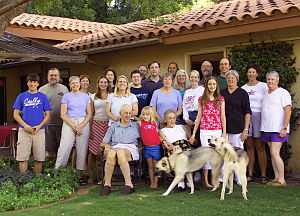Larned B. Asprey

Larned "Larry" Brown Asprey (March 19, 1919 – March 6, 2005) was an American chemist noted for his work on actinide and rare earth and fluoride chemistry, and for his contributions to nuclear chemistry on the Manhattan project and later.[1]
Asprey was born in Sioux City, Iowa; his parents were Gladys Brown Asprey and Peter Asprey Jr. He had an older sister and a younger brother: mathematician and computer scientist Winifred Asprey (1917–2007), founder of Vassar College's computer science department,[2] and military historian and writer Robert B. Asprey (1923–2009).[3]
Asprey received a chemistry B.S. at Iowa State University in 1940. When he enlisted in the U.S. Army in 1944, Asprey was assigned to the Manhattan Project's effort to separate and purify plutonium under Glenn T. Seaborg at the University of Chicago's Metallurgical Laboratory. There with Herbert H. Anderson he developed the PUREX process (Plutonium–URanium EXtraction); their patent "Solvent Extraction Process for Plutonium" was filed in 1947.[4]
In July 1945, Asprey was among the atomic-bomb scientists who signed the Szilárd petition to ask U.S. President Harry S. Truman to exercise extreme care in any decision to use the atomic bomb in the war.
In 1945, Asprey and Winston Manning measured the half-life of the synthetic isotope 95242 at about 16 hours; the transient isotope was made by irradiating an early sample of the as-yet-unnamed relatively stable 95241 with neutrons. The product after beta decay was yet another new element, 96242. These new unnamed elements created in the Met Lab in Chicago were announced to the world by Glenn Seaborg on Nov. 11, 1945, on the radio show Quiz Kids. Elements 95 and 96, originally called "pandemonium" and "delirium", were eventually named americium and curium by analogy with the chemically related elements europium and gadolinium. Asprey's later discovery, with S. E. Stephanou and Robert A. Penneman at Los Alamos, of the hexapositive, fluoride-soluble oxidation state of americium was one of the keys to the subsequent discovery of element 97, berkelium, at Berkeley, California in 1949.[5]
While working in Chicago, he met his future wife Margaret Williams, who also worked on the Manhattan Project there, and with whom he later had seven children.
After receiving his Ph.D. at University of California, Berkeley, and the birth of their first son, they moved to Los Alamos, New Mexico in 1949, to work for the Los Alamos National Laboratory, where he spent the rest of his career. He retired in 1986 after conducting more than thirty-five years of research on actinides and lanthanides and related chemistry.[4]
Asprey was the third awardee of the American Chemical Society's Glenn T. Seaborg Actinide Separations Award, in 1986.[6]
Larry's wife Margaret "Marge" W. Asprey also worked at Los Alamos, and was recognized for her work by the American Nuclear Society with the Walter H. Zinn Award in 2005, shortly after Larry's death.[7]
References
- ↑ "Dr. Larned "Larry" Brown Asprey". Obituaries. Albuquerque Journal. March 11, 2005.
- ↑ "Winifred "Tim" Asprey, computer pioneer and longtime professor at Vassar College, dies at 90". Vassar Office of College Relations.
- ↑ "New College Receives Gift from Estate of Robert B. Asprey". New College of Florida. June 15, 2009.
- ↑ 4.0 4.1 P. Gary Eller, Bob Penneman, and Bob Ryan (1st quarter 2005). "Pioneer actinide chemist Larned Asprey dies". The Actinide Research Quarterly. Los Alamos National Laboratory. pp. 13–17. Check date values in:
|date=(help) - ↑ Darleane C. Hoffman, Albert Ghiorso, and Glenn T. Seaborg (2000). The Transuranium People: the Inside Story. Imperial College Press. pp. 114–136. ISBN 978-1-86094-087-3.
- ↑ "The Glenn T. Seaborg Actinide Separations Award". 30th Actinide Separations Conference. Pacific Northwest National Laboratory. p. 8. Retrieved 13 December 2009.
- ↑ "Walter H. Zinn Award recipients". Honors and Awards, Recipients. American Nuclear Society. Retrieved February 14, 2011.